The Samsung Galaxy S6 and S6 edge Review
by Joshua Ho on April 17, 2015 9:00 AM EST- Posted in
- Smartphones
- Samsung
- Mobile
- Galaxy S6
- Galaxy S6 Edge
NAND Performance: The First UFS Phone
Storage performance is often a critical area for user performance, as applications cannot be cached in RAM at every possible moment. Camera performance is also often limited by storage performance as RAM buffers can only do so much to maintain performance before it’s necessary to commit photos to non-volatile storage.
However due to the memory hierarchy to some extent, storage performance is often hard to notice once it’s at a point where things are “good enough”. Unfortunately, in some cases we can see OEMs failing to include sufficiently performant solid-state storage, which can be a major pain point in the user experience when random read/write performance is low enough that there are noticeable IO pauses as the system has to wait for data to be loaded from storage.
The Samsung Galaxy S6 family is the first shipping implementation of UFS (Universal Flash Storage) 2.0 standard, which makes the internal storage model less like an SD card in nature. When comparing the eMMC 5.1 standard to the UFS 2.0 standard, we see a move from a the 400 MB/s maximum of the eMMC 5.1 standard with HS400 physical link interface to MIPI M-PHY, which allows for a theoretical maximum of around 720 MB/s and should be more efficient in transmitting data than the current eMMC standard. In addition, UFS makes it possible to do full duplex communication, which means that reads and writes can happen simultaneously. There's also a command queue, which helps to avoid inefficiencies that could arise from waiting for commands once a command has been processed by the storage controller, and utilizes the SCSI protocol to facilitate these new features at the interface level.
As for the Galaxy S6 itself, the UFS implementation Samsung is using is Samsung developed. Samsung's current implementation only supports up to 300 MB/s (or 2.4 Gbps) transfer rates as a theoretical maximum, so from an interface perspective it's still not reaching the full capabilities of the standard. Though even at a cap of 300MB/sec, it still stands to be a significant improvement over typical eMMC solutions.
Finally, on a technical note, the 32GB models are of the model KLUBG4G1BD-E0B1 with a maximum queue depth of 16.
In order to test storage performance, we use Androbench with some custom settings to get a reasonable idea of performance in this area, although this test isn’t an exhaustive examination of storage performance by any means.
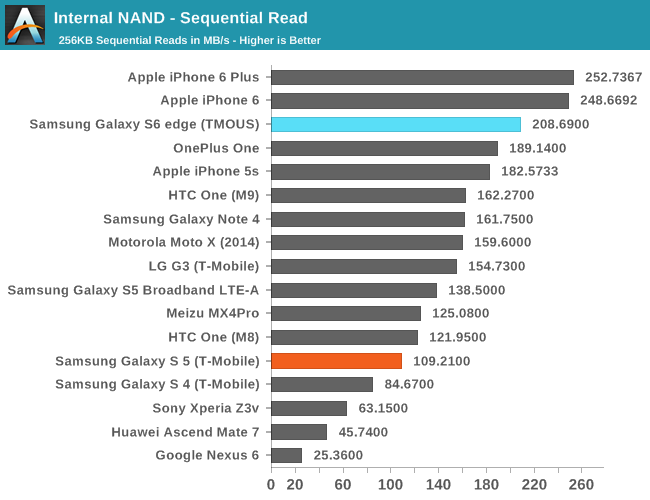
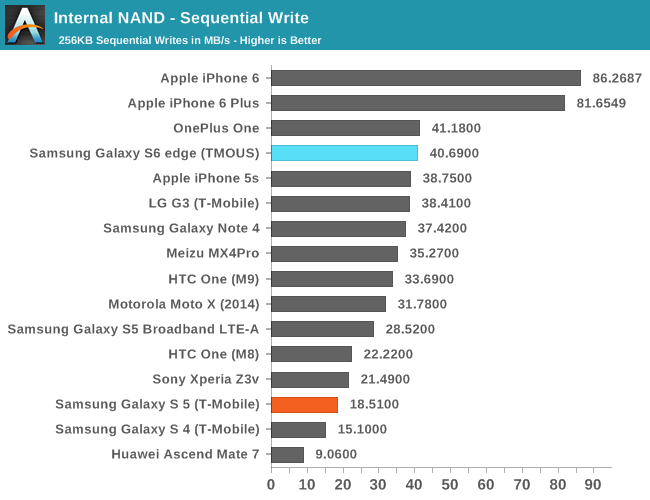
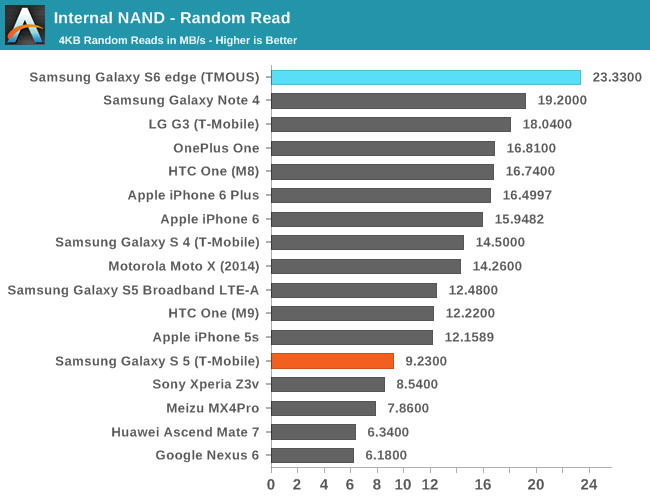
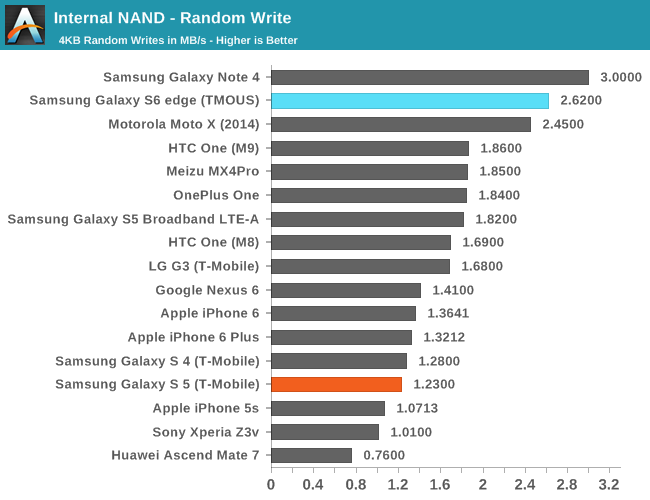
The Galaxy S6 performs rather impressively in our standard storage test, but not as fast as one might have hoped. This is due to the nature of the Androbench 3.6 test, which only tests a single IO thread, which won’t use the UFS storage of the Galaxy S6 to its full extent. In order to see the kind of difference that UFS really makes, I ran the same test again on Androbench 4.x, which does support multiple IO threads. However, as our iOS storage test and Androbench 3.6 don’t support more than a single IO thread we will continue to present both results for now.
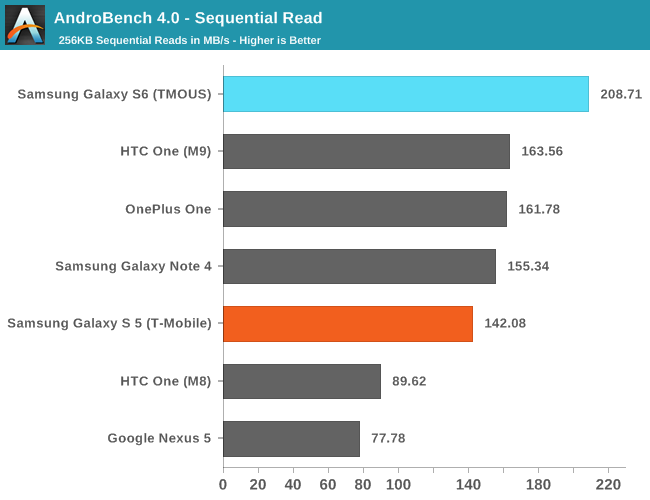
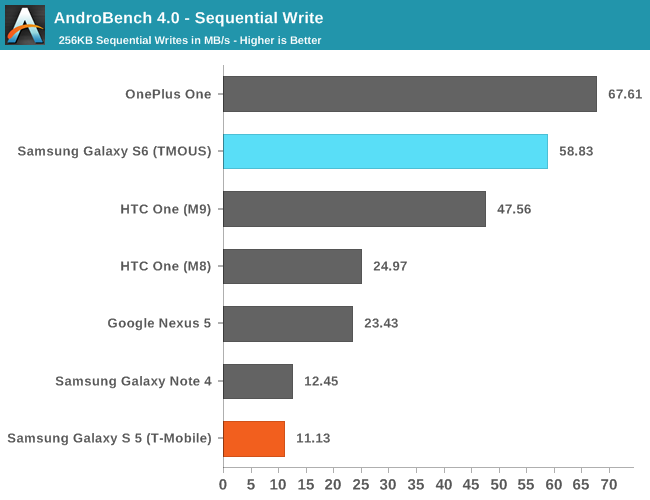
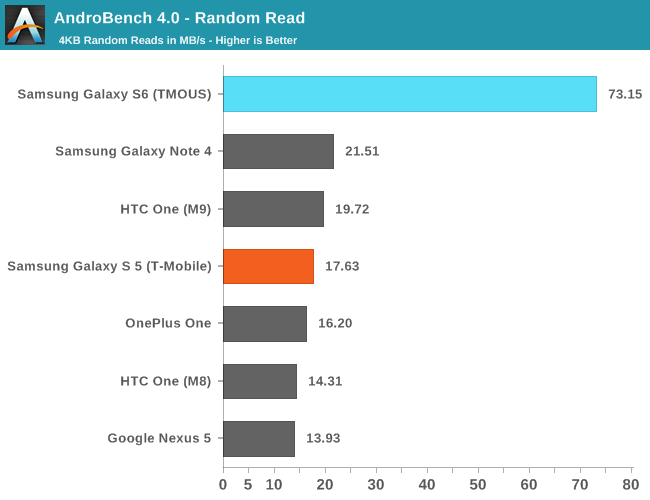
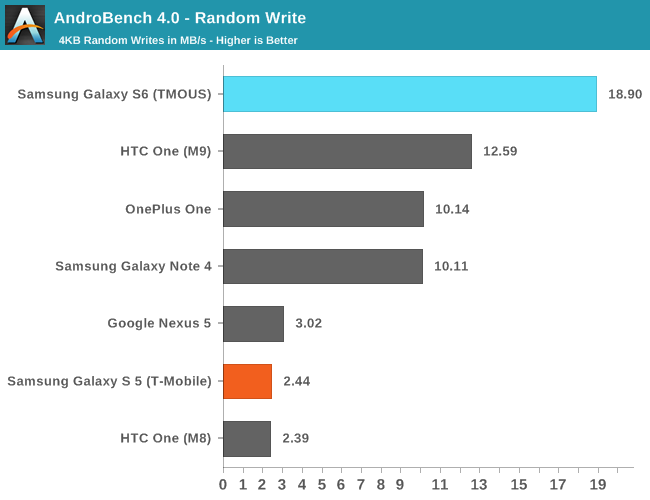
Overall, there are some immense benefits in storage performance here, especially in random IO performance. The Galaxy S6 has some of the fastest storage available in a phone today as far as I can tell given that this is basically a pure MLC solution, and shouldn’t have any real issue with storage performance holding back the rest of the phone over the course of 1-3 years as long as a reasonable amount of free space is kept to allow efficient storage management.


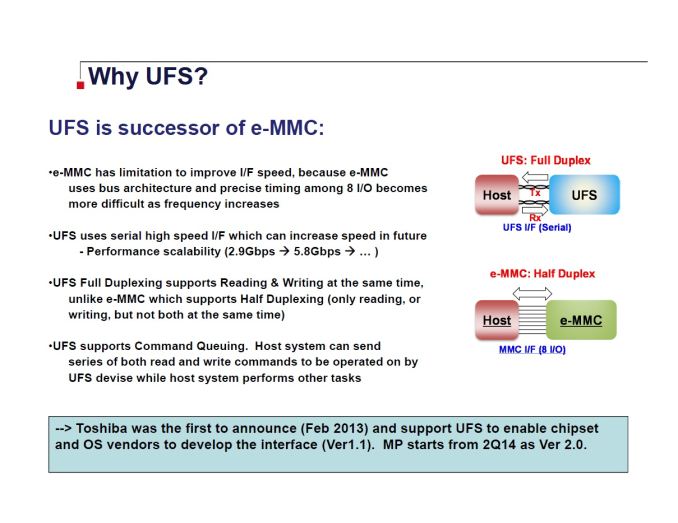








306 Comments
View All Comments
Vandam500 - Friday, April 17, 2015 - link
On the specs table in camera architecture you listed the S6 having a 20.1 megapixel camera but it has a 16 megapixel camera.JoshHo - Friday, April 17, 2015 - link
Apologies for the error, it has been corrected.cj100570 - Friday, April 17, 2015 - link
I love how reviewers keep calling the Galaxy S 5 a failure. Sure, it didn't sell as many units as Samsung may have hoped, but it was still the best selling Android phone of 2014 by a wide margin by all accounts. If that's failure, the other Android manufacturers need to learn how to fail so spectacularly.lilmoe - Friday, April 17, 2015 - link
+1FlushedBubblyJock - Friday, April 17, 2015 - link
Seriously, it was the highest seller by a lot and the reviewers condemned it... ?Well, the "elite snootsters" probably hate the peonic rabble public (privately, depths of their nerdgourd ), of course.
So anything they buy en masse "negates the need for the nerdy idiot reviewer overlord".
fenneberg - Friday, April 17, 2015 - link
+2Ryan Smith - Friday, April 17, 2015 - link
It was a good phone, don't get us wrong.However it did miss Samsung's sales expectations, and quite significantly. This is something that we think is important to point out, as understanding this helps to understand why Samsung made the design changes they did for the S6. Technology doesn't occur in a vacuum, so it's very useful to understand the business considerations as well.
name99 - Friday, April 17, 2015 - link
Well, now you know how people feel when they hear someone claim the iPhone 5C was a failure...The numbers I can find (which are obviously not the most recent) have the Galaxy 5S sales numbers as of Dec 2014 at 12 million, with the 5C sales as of July 2014 at 24 million.
lilmoe - Friday, April 17, 2015 - link
The 5C wasn't a "failure", just a *ripoff*...Speedfriend - Friday, April 17, 2015 - link
"I also see almost no benefit to the MST module as magstripe transactions will be obsolete by October of this year when United States banks switch over to chipped credit cards and will no longer accept liability for fraud in magstripe transactions."Firstly, only 50-60% of US POS terminals are expected to be EMV compliant by the year end.
And secondly many of the first wave of EMV POS terminals are not contactless enabled even here in the UK which has had both chip and pin and contactless for a while.
So Samsung magstrip payments will still be a useful product probaly for a number of years, especailly if it doesn't relay on a seperate agreement with the merchant like Apple's does.